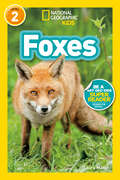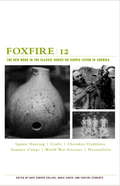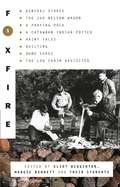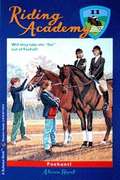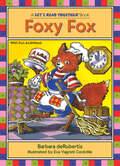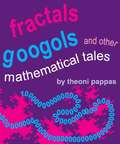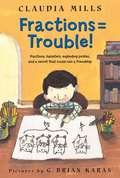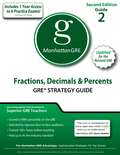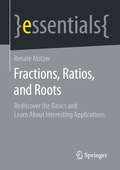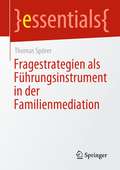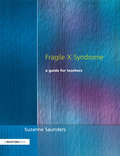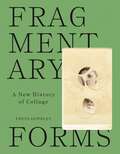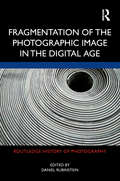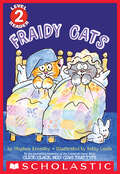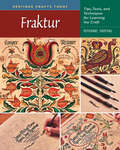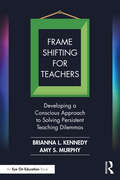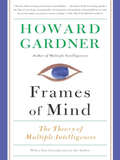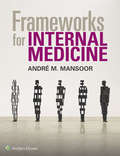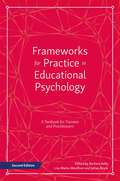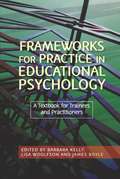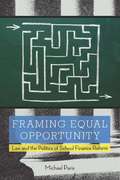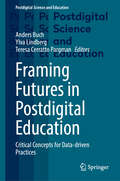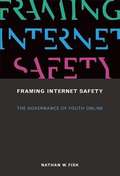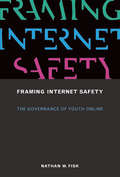- Table View
- List View
Foxes (Readers)
by Laura MarshMysterious, cunning, smart, and sleek, foxes are one of kids' favorite animals. Learn all about this fantastic forest canine!Packed with beautiful and engaging photos, this new leveled reader dives into the amazing world of foxes. Kids will learn all about fascinating foxes, including where they live, how they hunt, and what their families are like. National Geographic Readers' combination of expert-vetted text, brilliant images, and a fun approach to reading have proved to be a winning formula with kids, parents, and educators. Level 2 text provides accessible, yet wide-ranging information for kids ready to read on their own, perfect to encourage the scientists and explorers of tomorrow!
Foxfire 12
by Kaye Carver Collins Angie CheekFor more than thirty years, Foxfire books have brought the philosophy of simple living to hundreds of thousands of readers, teaching creative-self-sufficiency, the art of natural remedies, home crafts, and preserving the stories and customs of Appalachia. Inspiring and practical, this classic series has become an American institution. Foxfire 12 is the latest volume, the first in more than five years. Here are reminiscences about learning to square dance and tales about traditional craftsmen who created useful items in the old-time ways that have since disappeared in most of the country. Here are lessons on how to make rose beads and wooden coffins, and on how to find turtles in your local pond. We hear the voices of descendants of the Cherokees who lived in the region, and we learn about what summer camp was like for generations of youngsters. We meet a rich assortment of Appalachian characters and listen to veterans recount their war experiences. Illustrated with photographs and drawings, Foxfire 12 is a rich trove of information and stories from a fascinating American culture.
Foxfire 9 (Foxfire Series #9)
by Eliot WiggintonFoxfire highlights the twentieth year of the Foxfire high school program with a new volume as fascinating as its predecessors. Included are general stores, the Jud Nelson wagon, a praying rock, a Catawban Indian potter, haint tales, quilting, home cures, and the log cabin revisited.From the Trade Paperback edition.
Foxhunt! (Riding Academy #11)
by Alison HartJina's thrilled to be bringing her roommates home with her for Thanksgiving break -- and for the annual Middlefield Foxhunt. She and Andie can't wait to ride to hounds, but Mary Beth is horrified: What about the poor fox? She and Lauren launch a full-scale protest against fox hunting -- and soon it's an all-out war at Middlefield!
Foxy Fox: Short Vowel O (Let's Read Together ®)
by Barbara deRubertisLet&’s Read Together books merge rhyme and vowel sounds in delightfully zany stories kids will want to read again and again. Each of the 15 books in this classic series by award-winning author/educator Barbara deRubertis will give your child a jumpstart on reading success."Story lines are silly and inventive, and recall Dr. Seuss&’s Cat in the Hat for the building of rhythm and rhyming words." —School Library JournalFoxy Fox drops the pot and slops the mop. Will he lose his job at Mom and Po's shop? (This easy-to-read story features the short &“o&” vowel sound.)
Fractals, Googols, and Other Mathematical Tales
by Theoni PappasA treasure trove of stories that make mathematical ideas come to life. Explores math concepts and topics such as real numbers, exponents, dimensions, the golden rectangle in both serious and humorous ways. Stories such as the parable of p, the number line that fell apart, Leonhard the magic turtle and many others offer an amusing and entertaining way to explore and share mathematical ideas regardless of age or background. The reference section following each story is designed as enrichment information for the concepts presented in each story.
Fractions = Trouble!
by Claudia Mills G. Brian KarasIf Wilson Williams thought multiplication was difficult, he is finding fractions impossible. And when his parents hire a math tutor for him, he is sure he's the only kid in the history of Hill Elementary to have one. Wilson is determined to make sure that no one finds out, not even his best friend, Josh. At least his pet hamster, Pip, is sympathetic. Pip is going to be part of Wilson's science fair project, because any project with hamsters in it is bound to be wonderful. But Josh has the coolest project of all: at what temperature does a pickle explode? Unfortunately, it looks as if Wilson's secret may end up exploding their friendship. Claudia Mills' Fractions = Trouble is a fun and thoroughly relatable story that Kirkus Reviews calls an "excellent selection for early chapter-book readers. "
Fractions, Decimals & Percents: GRE Math Preparation Guide
by The Editors at the Manhattan GREThis book provides an in-depth look at the array of GRE questions that test knowledge of Fractions, Decimals, and Percents. Learn to see the connections among these part-whole relationships and practice implementing strategic shortcuts.
Fractions, Ratios, and Roots: Rediscover the Basics and Learn About Interesting Applications (essentials)
by Renate MotzerRenate Motzer introduces the world of fractions and connects them with decimal numbers. She clearly shows that fractions can be understood as parts of a whole, but also as ratios of two quantities. The author clearly shows why roots cannot be exactly indicated by fractions, how to find good approximations and why an unusual addition of fractions can lead to paradoxical results. Furthermore, she explains the use of fractions in percentage and probability calculations in a practical way and finally discusses different ways of forming mean values.This Springer essential is a translation of the original German 1st edition essentials, Brüche, Verhältnisse und Wurzeln by Renate Motzer, published by Springer Fachmedien Wiesbaden GmbH, part of Springer Nature in 2018. The translation was done with the help of artificial intelligence (machine translation by the service DeepL.com). A subsequent human revision was done primarily in terms of content, so that the book will read stylistically differently from a conventional translation. Springer Nature works continuously to further the development of tools for the production of books and on the related technologies to support the authors.
Fragestrategien als Führungsinstrument in der Familienmediation (essentials)
by Thomas SpörerFragestrategien haben für die Gesprächsführung in Mediationsverfahren inhaltlich und führungstechnisch eine zentrale Funktion. Dennoch spielen sie in den meisten Ausbildungsgängen zum Mediator/zur Mediatorin keine hervorgehobene Rolle. Dieser Band thematisiert u.a. eine beobachtbare allgemeine Unsicherheit bei Mediatoren bezüglich der systematischen Anwendung und Gestaltung von Fragestrategien.Er erläutert dabei exemplarisch anhand eines idealtypischen Mediationsverlaufs für Paare Schritt für Schritt die fragegestützte Gestaltung und Entwicklung solcher Einigungsprozesse und unterstreicht den damit entstehenden Nutzen eines solchen Weges nicht nur für die Betroffenen, sondern auch für die Mediatoren selbst.
Fragile X Syndrome: A Guide for Teachers
by Suzanne SaundersFragile X Syndrome is thought to be the most common inherited cause of learning difficulties. However many people have never heard of it and those who have, including many of the professionals who work with those affected by it, have little knowledge or understanding of the condition. This book brings up to date research with information and advice from teachers who are discovering, first hand, the best ways of educating children with Fragile X. It is much needed support and advice that will help teachers to understand the child with Fragile X and encourage maximum educational progress. / While the book is aimed at teachers, it is also an excellent resource for parents, therapists and any professional working with a child who has Fragile X.
Fragmentary Forms: A New History of Collage
by Freya GowrleyA beautifully illustrated global history of collage from the origins of paper to todayWhile the emergence of collage is frequently placed in the twentieth century when it was a favored medium of modern artists, its earliest beginnings are tied to the invention of paper in China around 200 BCE. Subsequent forms occurred in twelfth-century Japan with illuminated manuscripts that combined calligraphic poetry with torn colored papers. In early modern Europe, collage was used to document and organize herbaria, plant specimens, and other systems of knowledge. In the eighteenth and nineteenth centuries, collage became firmly associated with the expression of intimate relations and familial affections. Fragmentary Forms offers a new, global perspective on one of the world&’s oldest and most enduring means of cultural expression, tracing the rich history of collage from its ancient origins to its uses today as a powerful tool for storytelling and explorations of identity.Presenting an expansive approach to collage and the history of art, Freya Gowrley explores what happens when overlapping fragmentary forms are in conversation with one another. She looks at everything from volumes of pilgrims&’ religious relics and Victorian seaweed albums to modernist papiers collés by Pablo Picasso and Georges Braque and quilts by Faith Ringgold exploring African-American identity. Gowrley examines the work of anonymous and unknown artists whose names have been lost to history, either by accident or through exclusion.Featuring hundreds of beautiful images, Fragmentary Forms demonstrates how the use of found objects is an important characteristic of this unique art form and shows how collage is an inclusive medium that has given voice to marginalized communities and artists across centuries and cultures.
Fragmentation of the Photographic Image in the Digital Age (Routledge History of Photography)
by Daniel RubinsteinFragmentation of the Photographic Image in the Digital Age challenges orthodoxies of photographic theory and practice. Beyond understanding the image as a static representation of reality, it shows photography as a linchpin of dynamic developments in augmented intelligence, neuroscience, critical theory, and cybernetic cultures. Through essays by leading philosophers, political theorists, software artists, media researchers, curators, and experimental programmers, photography emerges not as a mimetic or a recording device but simultaneously as a new type of critical discipline and a new art form that stands at the crossroads of visual art, contemporary philosophy, and digital technologies.
Fraidy Cats (Scholastic Reader, Level 2)
by Stephen KrenskyWill these fraidy cats EVER get to sleep?The Fraidy Cats let their imaginations run wild one dark and noisy night. They imagine all sorts of scary things--from wild elephants to hungry wolves! With Stephen Krensky's easy-to-read text and Betsy Lewin's eye-catching artwork on every page, kids will keep turning the pages of this leveled reader!The new edition of this best-selling Scholastic Level 2 Reader features brand-new cover artwork from best-selling illustrator, Betsy Lewin.
Fraktur: Tips, Tools, and Techniques for Learning the Craft (Heritage Crafts)
by Ruthanne HartungCreate charming birth certificates and house blessings by mastering the decorative writing of the Pennsylvania Dutch—a folk art that lives on. The Pennsylvania Dutch are noted for the beautifully designed and hand-lettered documents known as fraktur. These include birth and marriage certificates, family trees, bookplates, awards, and house blessings. Leading fraktur artist Ruthanne Hartung adapts the craft to modern tastes and needs in this practical how-to book, with information on tools, step-by-step instructions, ideas for design, lettering and coloring techniques, and a variety of projects. An assortment of traditional patterns to apply to personal frakturs are included.
Frame Shifting for Teachers: Developing a Conscious Approach to Solving Persistent Teaching Dilemmas
by Brianna L. Kennedy Amy S. MurphyLearn how you can successfully address persistent teaching dilemmas by reframing how you think about and respond to them. The authors show how adopting habits of mind, including curiosity and an asset-based teaching approach, is necessary for tackling teaching challenges more effectively and equitably. Chapters explain how you can then apply frame shifting by considering your dilemma in three domains - relationships, classroom management, and curriculum and instruction. Practical examples, exercises, and discussion questions throughout the book will help you apply the concepts to your own teaching situation. In addition, a bonus online study guide contains reproducible templates, additional examples, suggested answers, and more. Appropriate for teachers to read independently or through book studies and PLCs, the book will leave you with new strategies for changing your beliefs and reactions, and ultimately improving how you approach and reach your students.
Frames Of Mind: A Rhetorical Reader With Occasions For Writing
by Robert DiYanni Pat C. HoyThe first full-color rhetorical reader with an integrated CD-ROM, FRAMES OF MIND: A RHETORICAL READER WITH OCCASIONS FOR WRITING treats the traditional rhetorical patterns not only as methods for effective writing, but as frames for critical thinking.
Frames of Mind: The Theory of Multiple Intelligences
by Howard GardnerFirst published in 1983 and now available with a new introduction by the author, Gardner's trailblazing book revolutionized the worlds of education and psychology by positing that rather than a single type of intelligence, we have several--most of which are neglected by standard testing and educational methods.
Frameworks for Internal Medicine
by Andre MansoorPublisher's Note: Products purchased from 3rd Party sellers are not guaranteed by the Publisher for quality, authenticity, or access to any online entitlements included with the product. Introducing an innovative, systematic approach to understanding differential diagnosis, Frameworks for Internal Medicine helps students learn to think like physicians and master the methodology behind diagnosing the most commonly encountered conditions in internal medicine.
Frameworks for Practice in Educational Psychology, Second Edition: A Textbook for Trainees and Practitioners
by Susan Dean Stephen Joseph Barbara Kelly Tommy Mackay Sandra Dunsmuir Geoff Lindsay Jane Leadbetter James Boyle Ioan Rees Gillian Rhydderch Patsy Wagner Fraser Lauchlan John Gameson Norah Frederickson Andrew Richards Bob Burden Jeremy Monsen Lisa Marks Woolfson Michael E. HarkerNow in its second edition, this comprehensive textbook presents a rich overview of approaches to educational psychology, through an in-depth exploration of both existing and emerging practice frameworks. Covering established techniques such as the Monsen et al. Problem-Solving Framework and the Constructionist Model of Informed and Reasoned Action, the book sets out new material on innovative methods and approaches such as Implementation Science and a Problem-Solving - Solution Focussed integrated model for service delivery. Accessible summaries are accompanied by perceptive assessments of how these frameworks meet modern needs for accountable, transparent and effective practice. Providing a definitive, up-to-date view of educational psychology, the book explains the complex, integrated methodology necessary to succeed in the field today. Thoughtful and clear, this textbook will be an invaluable resource for all practicing educational psychologists, students, trainers and educators.
Frameworks for Practice in Educational Psychology: A Textbook for Trainees and Practitioners
by Stephen Joseph Barbara Kelly Tommy Mackay Geoff Lindsay Jane Leadbetter James Boyle Ioan Rees Lisa Woolfson Andrew Richard Gillian Rhydderch Patsy Wagner Jey Monsen Fraser Lauchlan John Gameson Norah Frederickson Robert BurdenThis textbook assesses existing and emerging practice frameworks in educational psychology and their relation to theory. Covering current frameworks, such as the Monsen et al. Problem-Solving Framework, the Integrated Problem Solving Framework for Practitioners and the Constructionist Model, as well as emerging approaches, such as Systemic Solution Focussed Models and Positive Psychology Frameworks, contributors explore how they support educational psychology. The editors consider how existing and emerging frameworks help address current demands for professional accountability, transparency and effectiveness. They conclude with an exploration of the complex methodology and highly integrated approach required by contemporary educational psychologists. This textbook will be an invaluable resource for all practising educational psychologists, students, trainers, and educators.
Framing Equal Opportunity
by Michael ParisIn order to illuminate the crucial and often neglected role of legal translation in litigation-driven reform efforts, Paris (political science, City U. of New York-College of Staten Island) explores legal aspects--lawyers, rights claims, litigation, courts, and the like--in struggles to produce more egalitarian school finance and education policies. He focuses attention on would-be reformers and their mobilization of law and courts. Comparative case studies in New Jersey 1970-2009 and Kentucky 1983-2009 demonstrate details about the interplay between law and politics in litigation-based reform projects. Annotation ©2010 Book News, Inc. , Portland, OR (booknews. com)
Framing Futures in Postdigital Education: Critical Concepts for Data-driven Practices (Postdigital Science and Education)
by Anders Buch Teresa Cerratto Pargman Ylva LindbergThis book unpacks key concepts and methods relevant for a critical and reflective framing of futures in postdigital education. The compiled chapters explore concepts and methods that have pertinence for contemporary debates about the emergence of data-driven education and scrutinize implicit or explicit ethical and normative implications. The book provides in-depth critical reflections and perspectives to engage and analyze data-driven education as an educational and cultural phenomenon. It focuses on the value-laden and ethical aspects reflected in educational imaginaries (discourses and practices) regarding emerging data-driven sociotechnical practices in education. The book is the result of scholarly exchanges between disciplines at a symposium held at VIA University College in Denmark in May 2022.
Framing Internet Safety: The Governance of Youth Online
by Nathan W. FiskSince the beginning of the Internet era, it has become almost impossible to discuss youth and technology without mentioning online danger -- pornography that is just a click away, lurking sexual predators, and inescapable cyberbullies. In this book, Nathan Fisk takes an innovative approach to the subject, examining youth Internet safety as a technology of governance -- for information technologies and, by extension, for the forms of sociality and society they make possible. He argues that it is through the mobilization of various discourses of online risk that the everyday lives of youth are increasingly monitored and policed and the governing potentials of information technologies are explored. Fisk relates particular panics over youth Internet safety to patterns of technological adoption by young people, focusing on the policy response at the federal level aimed at producing future cybercitizens. He describes pedagogies of surveillance, which position parents as agents of surveillance; the evolution of the youth Internet safety curricula, as seen through materials on cyberbullying and online reputation management; and, drawing on survey results and focus groups, parent and child everyday practice. Finally, Fisk offers recommendations for a "cybersafety of everyday life," connecting youth Internet safety to trends in national infrastructure protection and corporate information assurance.
Framing Internet Safety: The Governance of Youth Online (The John D. and Catherine T. MacArthur Foundation Series on Digital Media and Learning)
by Nathan W. FiskAn examination of youth Internet safety as a technology of governance, seen in panics over online pornography, predators, bullying, and reputation management.Since the beginning of the Internet era, it has become almost impossible to discuss youth and technology without mentioning online danger—pornography that is just a click away, lurking sexual predators, and inescapable cyberbullies. In this book, Nathan Fisk takes an innovative approach to the subject, examining youth Internet safety as a technology of governance—for information technologies and, by extension, for the forms of sociality and society they make possible. He argues that it is through the mobilization of various discourses of online risk that the everyday lives of youth are increasingly monitored and policed and the governing potentials of information technologies are explored. Fisk relates particular panics over youth Internet safety to patterns of technological adoption by young people, focusing on the policy response at the federal level aimed at producing future cybercitizens. He describes pedagogies of surveillance, which position parents as agents of surveillance; the evolution of the youth Internet safety curricula, as seen through materials on cyberbullying and online reputation management; and, drawing on survey results and focus groups, parent and child everyday practice. Finally, Fisk offers recommendations for a “cybersafety of everyday life,” connecting youth Internet safety to trends in national infrastructure protection and corporate information assurance.
